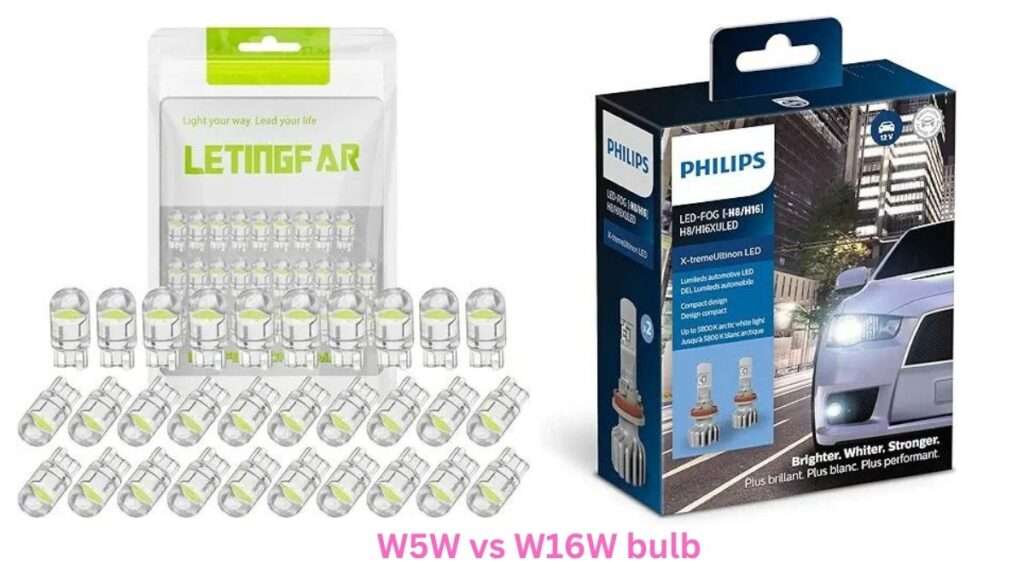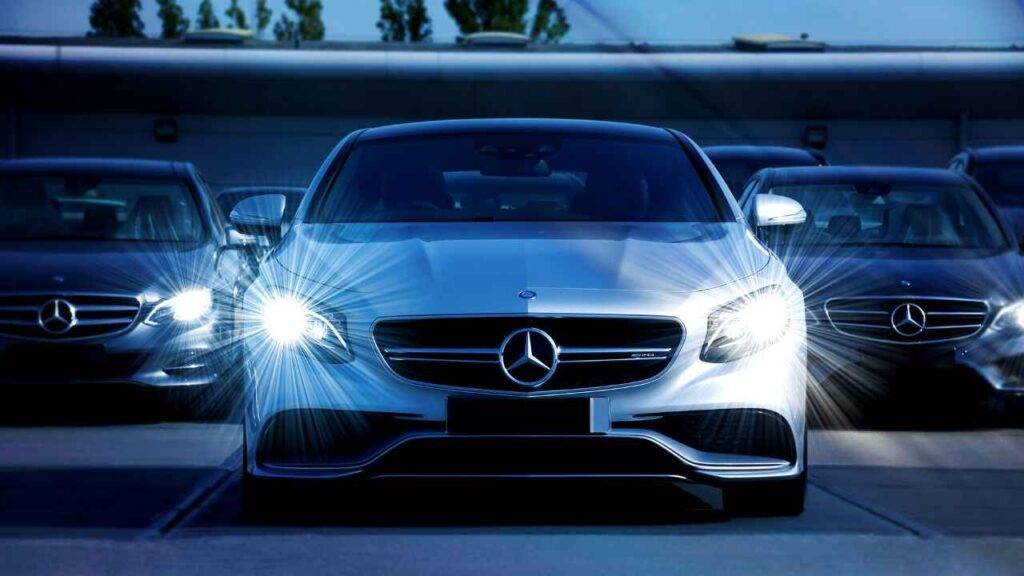When it comes to automotive lighting, selecting the right bulb is more than just a choice between brightness or appearance. It’s about safety, efficiency, and ensuring compatibility with your vehicle. Among the many bulbs available, W5W vs W16W bulb are two common options, each with its unique features and benefits.
In this detailed guide, we’ll explore the key differences between W5W and W16W bulbs, their applications in modern vehicles, and how to choose the right one for your car. If you’re ready to enhance your vehicle’s lighting, keep reading to understand which of these bulbs fits your needs.

Understanding W5W vs W16W Basics
1. Definition of W5W and W16W Bulbs
W5W and W16W are both types of small automotive bulbs commonly used in different lighting functions within vehicles. W5W bulbs are compact, low-wattage bulbs typically used for minor lighting tasks. On the other hand, W16W bulbs are larger and emit brighter light, making them suitable for more demanding applications.
2. Brief History and Development
Over the years, automotive lighting has evolved significantly. W5W bulbs have been around for a while and have found their place in various interior and exterior vehicle functions. Meanwhile, W16W bulbs, with their higher output, emerged later to meet the growing demand for brighter, more efficient lighting in cars.
3. Common Applications in Vehicles
W5W bulbs are often used in license plate illumination, interior lighting, and side marker lights. W16W bulbs are frequently found in reverse lights and daytime running lights (DRLs). Both bulb types play critical roles in enhancing a vehicle’s visibility and safety on the road.
Key Differences Between W5W and W16W
i). Physical Dimensions and Base Types
One of the main differences between these two bulbs is their size. The W5W bulb is smaller and has a standard T10 base, making it easy to install in tight spaces like license plate or interior light sockets. The W16W bulb, in contrast, is bulkier, often with a W2.1×9.5d base, designed for reverse light housings or other exterior applications.
ii). Wattage and Power Consumption
The W5W bulb operates at about 5 watts, while the W16W bulb is a more powerful 16-watt bulb. This makes the W16W significantly brighter, but also a bit more demanding on your vehicle’s electrical system. However, with advancements in energy-efficient car bulbs, many W5W and W16W options now come in LED variants, which consume far less energy than their traditional halogen counterparts.
iii). Brightness and Lumens Output
When comparing lumens output, the W5W is designed for tasks that require less light, such as interior car lighting or license plate illumination. The W16W, however, delivers a higher lumens count, making it ideal for exterior tasks like reverse lights where visibility is crucial.
iv). Color Temperature and Light Quality
Both bulbs offer different color temperature options, from warm halogen tones to cooler, brighter LED lighting. The W16W is typically available in brighter, cooler white light, providing clearer visibility at night, whereas W5W bulbs are more versatile and can be found in various colors depending on your needs.
Applications and Uses in Modern Vehicles
1. W5W Typical Uses
The W5W bulb is primarily used for low-light applications where you don’t need extreme brightness. Some common uses include:
- License plate lights Interior dome lights
- Glove box light bulbs
- Dashboard illumination:
These bulbs are small, efficient, and offer just the right amount of light for these tasks.
2. W16W Typical Uses
On the other hand, W16W bulbs are commonly found in:
- Reverse lights
- Daytime running lights (DRLs)
- Turn signal bulb types
Their higher brightness makes them perfect for situations where visibility and safety are paramount.
Compatibility with Different Car Makes and Models
Before making your purchase, it’s essential to check your car’s manual for OEM bulb replacements to ensure compatibility. W5W vs W16W bulbs are widely used across different vehicle models, but compatibility can vary, especially with aftermarket lighting options.
Performance Comparison
i). Lifespan and Durability
LED vs. halogen bulbs is a common debate when comparing lifespan. LED W5W and W16W bulbs can last much longer than halogen versions, with some lasting over 25,000 hours. This makes LEDs a great option if you want to reduce the frequency of bulb replacements.
ii). Energy Efficiency
In terms of energy efficiency, LED W5W bulbs tend to consume less power than halogen counterparts, saving you money in the long run. The same goes for W16W LEDs, which offer bright light with minimal energy consumption, ensuring your car’s electrical system isn’t overburdened.
Heat Generation and Impact on Surrounding Components
Halogen bulbs, including traditional W5W and W16W, generate more heat than LEDs. This heat can sometimes damage nearby components. Choosing an LED variant can significantly reduce heat dissipation and increase the overall safety of your car’s lighting system.
Visibility and Safety Considerations
In terms of automotive safety lighting, W16W offers superior visibility, especially in reverse light applications. A brighter bulb improves your ability to see obstacles, while also making your vehicle more visible to others. However, W5W bulbs are still a great option for non-essential lighting like license plates and interiors.
Installation and Replacement
1. Tools Required
For both W5W vs W16W, the installation process is straightforward and typically only requires basic tools:
- A flathead screwdriver to remove any protective casing.
- A clean cloth to handle the new bulbs without touching them directly.
2. Step-by-Step Guide for Replacing W5W and W16W Bulbs
- After turning off your automobile, take the keys out.
- Locate the bulb housing and remove the protective cover.
- Remove the old bulb by gently pulling it out.
- Insert the new W5W or W16W bulb, ensuring it fits securely.
- Replace the cover and test the bulb to ensure it works properly.
Common Mistakes to Avoid
Touching the bulb with bare hands (oil from your skin can shorten its lifespan)
Forgetting to check compatibility with your car’s CAN-bus system, which may cause issues with some aftermarket bulbs.
Cost Analysis
Initial Purchase Price Comparison
W5W bulbs tend to be cheaper due to their lower wattage and simpler design. On average, W5W bulbs cost between $2 and $10, while W16W bulbs can range from $5 to $20, depending on whether you opt for LED or halogen.
Long-Term Cost Considerations
While the initial cost of W16W bulbs is higher, their longer lifespan and energy efficiency make them more cost-effective over time, especially if you opt for LED versions.
Value for Money Assessment
Overall, LED W5W and W16W bulbs provide the best value for money, offering longevity, brightness, and efficiency at a reasonable price.
Legal Considerations and Regulations
Road Safety Regulations Regarding Bulb Types
Make sure that any bulbs you install comply with ECE regulations (in Europe) or DOT-approved bulbs (in the U.S.). Non-compliant bulbs could fail inspections and might even lead to fines.
Potential Legal Issues with Incorrect Bulb Usage
Using an incorrect bulb, such as placing a W5W where a brighter W16W is required, can result in decreased visibility, leading to accidents or legal troubles.
Regional Differences in Automotive Lighting Laws
Check your local regulations for any restrictions or requirements specific to your area, as some regions have strict rules about bulb types and brightness levels.
Environmental Impact
1. Energy Consumption and Carbon Footprint
LED bulbs are far more energy-efficient, consuming up to 80% less energy than halogen bulbs. This makes both W5W and W16W LED variants more eco-friendly choices, reducing your carbon footprint.
2. Disposal and Recycling Considerations
When it comes to disposal, it’s important to recycle your old bulbs, especially LEDs, which contain materials that should not end up in landfills.
3. Eco-Friendly Alternatives and Future Trends
As smart car lighting systems and eco-friendly automotive lighting options become more popular, expect to see even more energy-efficient car bulbs on the market, further reducing environmental impact.
Conclusion: Your Enlightened Decision
Choosing between W5W vs W16W bulbs ultimately comes down to your vehicle’s needs and your personal preferences. For smaller, less demanding tasks, the W5W is a perfect fit. But for critical visibility and safety functions, the W16W provides the power and brightness required.
Both bulbs offer reliable performance, and if you opt for LED versions, you’ll enjoy added energy savings, longer lifespan, and better overall value. So, don’t leave your car’s lighting to chance. Pick the right bulb today and drive with confidence!
Ready to upgrade your car’s lighting? Make the switch now and ensure the road ahead is well-lit and safe!
Related articles:


